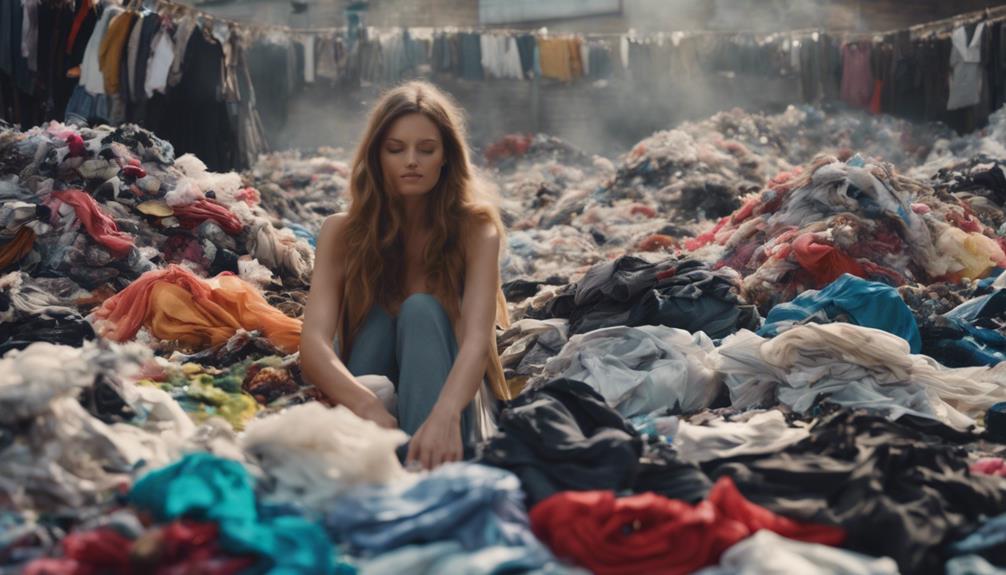Thrifting is often viewed as a sustainable fashion choice, but there’s a deeper story to it. While it does help prolong the life of clothing and decrease the demand for new items, the quality of many thrifted pieces can be questionable. Fast fashion brands play a significant role in thrift store stocks, which ultimately hinders sustainability efforts. Approximately 70-80% of donations come from these lower-quality sources, with only a small fraction actually being resold. Excessive thrift shopping can also lead to increased waste. If you’re interested in finding a balance between thrift shopping and sustainable practices, there’s a lot more to learn about this subject.
Key Takeaways
- Thrifting can extend the lifecycle of clothing, reducing demand for new garments and minimizing environmental impact.
- A significant portion of thrift store donations comes from fast fashion, which complicates sustainability efforts and increases landfill contributions.
- Many thrifted items are low-quality, leading to quick obsolescence and further waste, undermining the sustainability narrative.
- Rising prices and poor-quality donations limit access to thrift stores for low-income shoppers, affecting their availability of usable clothing.
Understanding Thrifting and Sustainability
Thrifting plays an essential role in promoting sustainability by extending the lifecycle of clothing and reducing the demand for new garments. When you engage in thrift shopping, you're not just scoring unique pieces; you're actively participating in the sustainable fashion movement. Each item you rescue from a thrift store helps decrease the overwhelming waste generated by the fast fashion industry, which produces low-quality clothing that often ends up in landfills.
With approximately 70% of clothing made from synthetic fibers, the environmental impact of these garments is significant. By choosing secondhand items, you're reducing the need for new production and the pollution associated with manufacturing. As the global secondhand apparel market continues to grow, it reflects a collective shift toward more sustainable fashion choices.
However, it's vital to contemplate your donation practices, as thrift stores only sell about 10-30% of the clothes they receive. The rest can contribute to landfill waste if not managed properly.
The Fast Fashion Dilemma

The rise of fast fashion brands complicates the thrift shopping experience, flooding stores with low-cost, low-quality items that challenge the sustainability narrative. In recent years, you've probably noticed an influx of donated clothes from these brands, like Shein and PrettyLittleThing. In 2022, donations of Shein items surged by 186%, while PrettyLittleThing saw a 75% increase compared to 2020. Many of these garments are new or nearly new, often still sporting tags, which raises questions about their sustainability.
The environmental impact of fast fashion is staggering. Over 60% of fabric fibers in current clothing come from synthetic sources derived from fossil fuels. This contributes to a decline in the durability of clothing, resulting in increased textile waste and pollution.
You might think that thrift shopping is a sustainable choice, but the reality is that many of these fast fashion donations perpetuate the problem rather than solve it. As you sift through racks of thrifted items, you may find yourself questioning whether these low-quality pieces truly align with sustainable fashion ideals. It's crucial to reflect on the origins of these garments as you shop.
The Role of Thrift Stores

Amid growing concerns about sustainability, thrift stores play a crucial role in promoting eco-friendly practices and supporting local communities. By selling second-hand goods, they help reduce waste and extend the lifecycle of clothing, making them essential players in the sustainable fashion movement. Every year, thrift stores process around six billion pounds of donations, greatly contributing to the second-hand economy.
However, the rise of low-cost, low-quality fast fashion has complicated this landscape. Many thrift stores struggle with inventory management as the influx of donations increases, often resulting in excess stock that can't be sold. This challenge can lead to higher prices for second-hand goods, which might alienate budget-conscious shoppers.
Despite these hurdles, thrift stores remain community hubs, fostering social connections and providing job opportunities. They support local economies while encouraging eco-conscious shopping habits.
Misconceptions About Thrifting

You might think thrifting is a straightforward way to shop sustainably, but there are some misconceptions that can cloud the reality.
Many people assume all donated clothes are in great shape, when in fact, fast fashion items often show up in poor condition.
Plus, while thrifting can offer affordable options for low-income shoppers, the rising popularity among higher-income consumers raises questions about access and equity.
Environmental Impact Misunderstandings
Many people believe that thrifting is a foolproof way to promote sustainability, but this perception often overlooks the complexities of textile waste and fast fashion's impact on the environment.
While you might think donating fast fashion clothes contributes to a greener planet, consider this: thrift stores only manage to sell 10-30% of donated items. The rest often ends up in landfills or is sent to recyclers, which creates an additional burden.
Many fast fashion garments are low-quality and made from synthetic fibers, resulting in non-biodegradable waste that pollutes our environment for years. It's crucial to recognize that over 60% of fabric fibers in clothing today are synthetic, exacerbating the textile waste crisis. When you donate these low-quality items, you're not necessarily helping the planet; instead, you could be contributing to a cycle of waste.
You might think thrifting reduces waste, but the reality is that the production and disposal of fast fashion contribute considerably to environmental degradation. So, while thrifting has its merits, it's not a silver bullet for sustainability. Understanding these nuances can help you make more informed choices about your clothing consumption.
Quality of Donated Items
Thrift stores often grapple with a surge of low-quality fast fashion items that can undermine their sustainability goals. You might think that donating clothing guarantees it's all reusable, but the reality is stark. A staggering 70-80% of donated items often come from fast fashion brands, which are notorious for producing clothing that lacks durability.
With over 60% of the fabrics used in these items being synthetic and sourced from fossil fuels, the quality of donated items can greatly impact the sustainability narrative.
While it's true that many donated pieces are new or nearly new, often still with tags, this only adds to the inventory overload. Thrift stores typically manage to sell only 10-30% of the donations they receive. The excess often ends up being sold to recyclers or exported, complicating the sustainability message you might associate with thrifting.
Moreover, changing fashion trends mean many items become undesirable quickly, leading to increased waste. So, the next time you're considering donating, remember that the quality of donated items matters just as much as the act of giving itself.
Accessibility for Low-Income Shoppers
The rising popularity of thrifting among higher-income shoppers has made it increasingly difficult for low-income individuals to access affordable clothing. Thrift stores, once a sanctuary for budget-conscious shoppers, now face challenges due to price hikes and a surge in demand. This shift raises ethical concerns about the accessibility for low-income shoppers who rely on these resources.
| Factor | Impact on Low-Income Shoppers |
|---|---|
| Rising Prices | Increased difficulty affording items |
| Poor Quality Donations | Limited availability of usable clothing |
| Fast Fashion Donations | Overwhelming quantity of low-quality items |
| Higher-Income Dominance | Alienation of original target demographic |
As operational costs rise, many thrift stores find themselves pricing out their core consumers. The influx of fast fashion donations, often in poor condition, complicates things further. This creates a cycle where low-income shoppers struggle to find quality items while higher-income individuals dominate the space. It's essential to acknowledge this shift and consider how it affects those who genuinely need affordable clothing.
Overconsumption and Its Impact

Overconsumption of thrifted items can inadvertently contribute to landfill emissions, as shoppers often buy more than they truly need. When you purchase excess clothing from thrift shops, you're part of a cycle that increases textile waste, undermining the sustainability goals of thrifting. Surprisingly, about 80% of donated clothes end up in landfills or incinerators, a stark reminder of how overconsumption complicates the efforts to manage clothing waste effectively.
The fast fashion industry produces around 100 billion garments each year, flooding thrift shops with an overwhelming supply of second-hand clothing. This influx makes it harder for sustainable practices to take root while driving up prices that can alienate low-income consumers who once relied on these stores for affordable options.
Moreover, many people only wear about 20% of their wardrobes, highlighting a significant disconnect between purchasing habits and actual usage. This gap not only leads to wasted resources but also contributes to the ongoing problem of textile waste.
Sustainable Practices in Thrifting
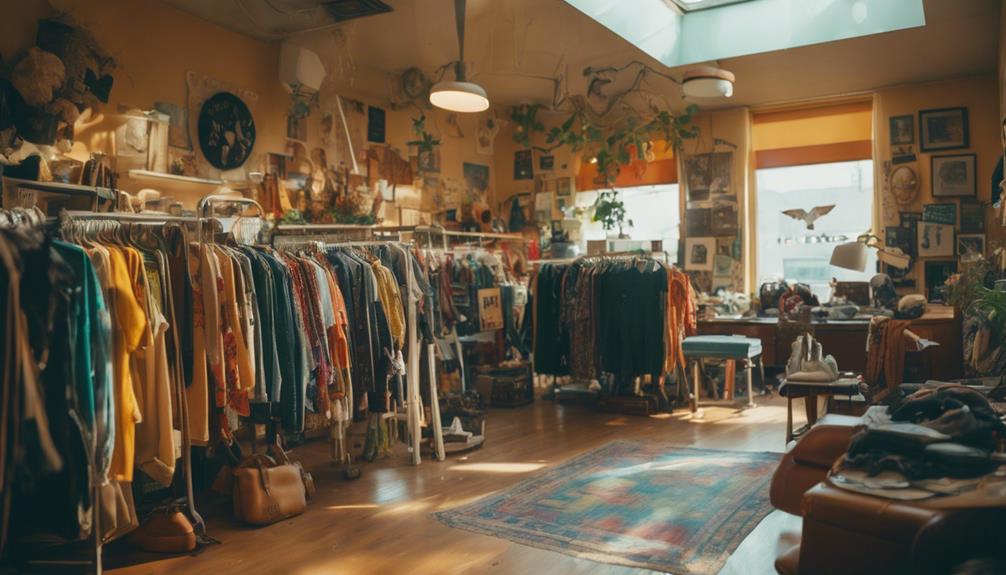
Sustainable practices in thrifting can greatly lower your carbon footprint by extending the life of garments and reducing the demand for new production. When you choose to thrift, you're actively participating in a more eco-friendly fashion cycle. This not only helps reduce carbon emissions but also conserves precious resources, as creating new clothing, especially in fast fashion, often involves immense water consumption and synthetic materials that can take centuries to decompose.
Here are some key sustainable practices to take into account while thrifting:
- Quality over Quantity: Focus on buying high-quality items that will last, reducing the need for frequent replacements.
- Mindful Donations: Make sure you're donating clothes that are in good condition. Avoid fast fashion items, as they can complicate the sustainability efforts of thrift stores.
The Journey of Donated Clothes
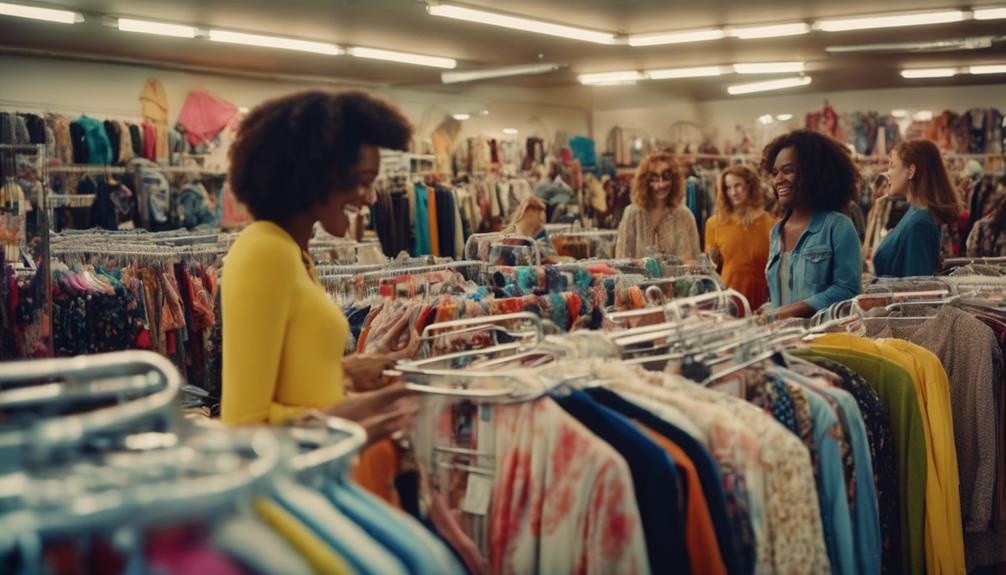
When you donate clothes, they begin a journey that influences not only the environment but also the economy and community around you. About 10-30% of donated clothes make it to thrift stores, where they can find new life.
However, the rest often face a grim fate, ending up in salvage operations or being sold to for-profit recyclers. Many fast fashion items you donate might still be new or nearly new, sometimes even carrying tags. This highlights the issue of overconsumption in fast fashion, leading to an influx of low-quality items.
Unfortunately, excessive donations can overwhelm thrift store operations, complicating their ability to manage inventory. Unsold items frequently end up in landfills, which undermines sustainability efforts.
Moreover, the majority of discarded clothing is exported to developing countries, where it can disrupt local economies and hinder domestic clothing production. This cycle reinforces the need for thoughtful donation practices.
Your choices matter—understanding the journey of your donated clothes can help reduce waste and promote a more sustainable approach to fashion, supporting both local communities and environmental conservation.
Ethical Considerations in Thrifting
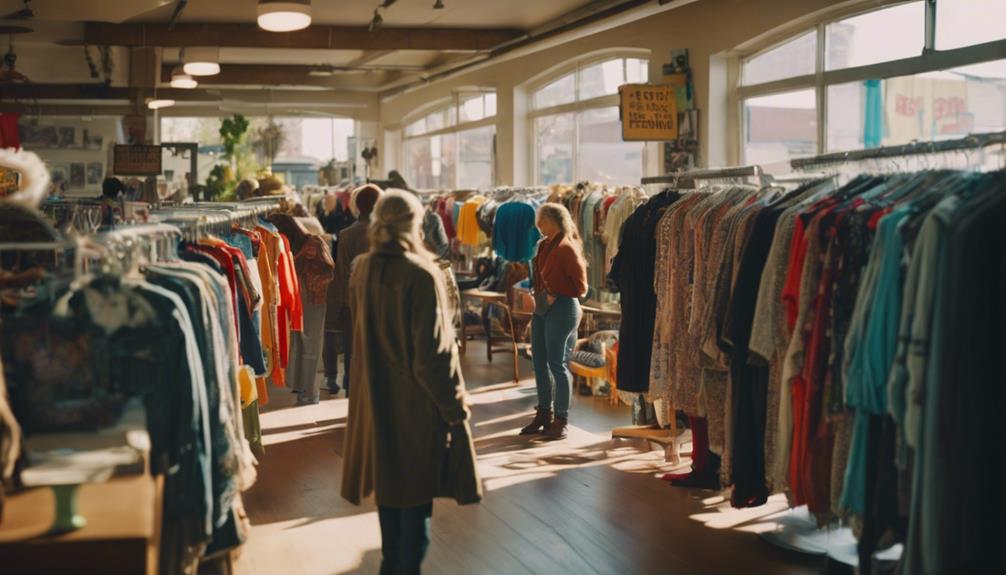
The journey of donated clothes raises important ethical questions about thrifting, particularly regarding accessibility and the impact on low-income shoppers. While thrifting can empower individuals by offering quality used goods at affordable prices, the rise of higher-income consumers in secondhand markets complicates this picture.
It's vital to reflect on how these dynamics affect those who genuinely need affordable clothing options.
- The influx of fast fashion donations often leads to a dilution of quality, as many items are barely used and may not meet the needs of low-income shoppers.
- Brand awareness influences the choices of low-income shoppers, prompting debates about whether buying secondhand is ethical compared to supporting sustainable brands.
As you navigate the thrifting landscape, keep these ethical considerations in mind. It's important to guarantee that thrifting remains a viable option for everyone, especially those who rely on it for essential clothing needs.
Balancing accessibility with the growing popularity of thrifting presents a challenge that requires awareness and thoughtful action.
Innovations for a Sustainable Future

Innovations in fashion are reshaping how we think about clothing, making it easier for you to embrace a more sustainable wardrobe. Brands are increasingly adopting sustainable materials, like H&M's Lyocell, which reduces water usage and pesticide reliance. This shift not only benefits the environment but also encourages you to choose eco-friendly options.
Moreover, thrift shops play an essential role in promoting sustainability. They contribute to a $64 million market, helping extend the lifecycle of clothing. By purchasing second-hand items, you actively participate in a circular economy, giving clothes a second chance and reducing waste.
Additionally, advancements in recycling technologies allow unsellable garments to be transformed into new products, further minimizing waste. This innovation means that even items that might seem useless can find new life, supporting the sustainable fashion cycle.
Through awareness campaigns, consumers like you can learn about responsible shopping and donating practices. This education is critical for fostering a more sustainable mindset. By embracing these innovations, you not only enhance your wardrobe but also contribute to a healthier planet, making a positive impact through your fashion choices.
Navigating Thrift Shopping Responsibly
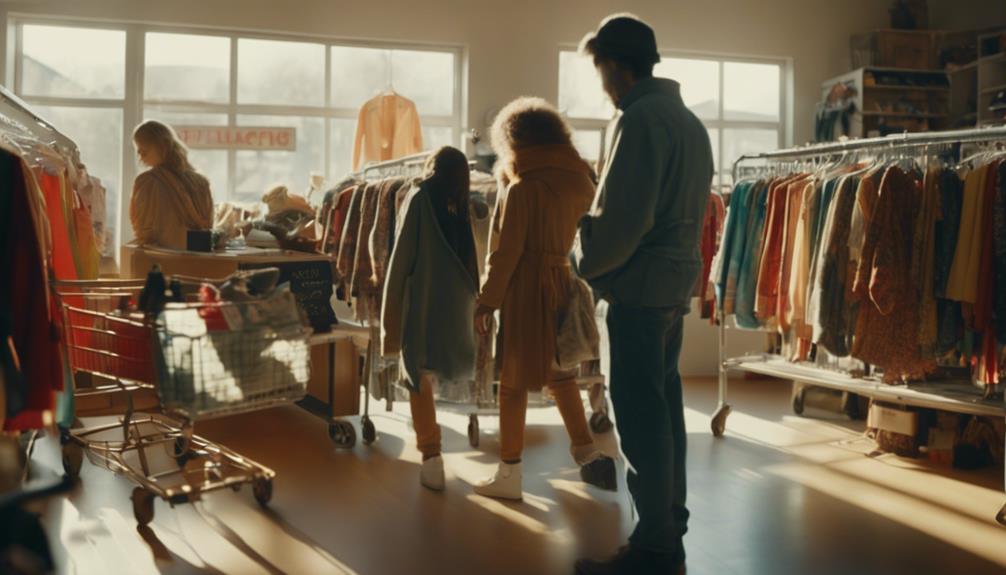
Embracing thrift shopping not only enhances your wardrobe but also allows you to make responsible choices that benefit the planet. By choosing pre-loved items, you directly combat the negative impacts of fast fashion, such as pollution and resource depletion. However, steering through thrift shopping responsibly requires mindfulness.
Here are some tips to keep in mind:
- Evaluate Repairability: Before purchasing, ask yourself if the item can be easily mended to extend its lifecycle.
- Outfit Versatility: Look for pieces that can create multiple outfits to maximize your investment and promote sustainable practices.
Moreover, be aware of donation practices. A staggering 70-90% of donated clothing isn't sellable and may end up in landfills. By being selective about your purchases and supporting unique, high-quality pieces, you contribute to a thrift ecosystem that prioritizes sustainability.
Frequently Asked Questions
Is Thrifting Considered Sustainable Fashion?
You might see thrifting as sustainable fashion since it promotes reusing clothing and reduces waste. However, consider the quality of donated items, as many end up in landfills, challenging its overall sustainability impact.
What Is the Dark Side of Thrifting?
Thrifting can have downsides. You might unknowingly contribute to waste by donating low-quality fast fashion items. These often end up in landfills, undermining the sustainability benefits you hoped to support when shopping secondhand.
Do People Really Care About Sustainable Fashion?
Oh sure, you're totally indifferent to sustainable fashion—just like you don't care about climate change, right? But let's be real; most people actually do care, seeking eco-friendly choices and pushing brands to step up.
Is It Ethical to Go Thrifting?
When you consider thrifting, think about its impact. It can help you save money and find unique items, but you should also be mindful of how your choices affect those who rely on thrift stores.
Conclusion
Thrifting can definitely be a sustainable fashion choice, but it's crucial to approach it mindfully. One of the benefits of thrifting is that it gives clothing a second life, reducing the demand for new items and lowering the overall environmental impact of the fashion industry. However, it’s important to remember that not all thrifted items are created equal. Some may have been discarded because they were no longer wearable, while others may have been donated due to changes in size or style preference. This is where sustainable fashion affordability comes into play, as thrifting allows for the purchase of high-quality items at a fraction of the cost compared to buying new.
Did you know that the average American throws away about 81 pounds of clothing each year? By choosing thrifted items instead, you're not just scoring unique finds but also helping reduce waste.
So, next time you shop, remember that every piece you save from the landfill makes a difference.
Embrace thrifting as a fun, responsible way to express your style sustainably!





